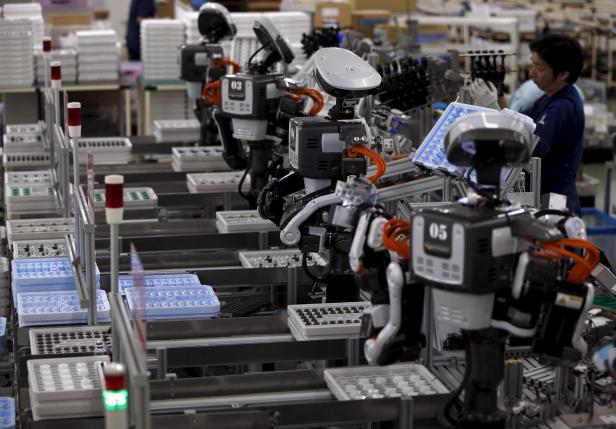
Factory worker Satomi Iwata has new co-workers, a troupe of humanoid automata that are helping to address two of Japan's most pressing concerns - a shortage of labor and a need for growth.
Factory worker Satomi Iwata has new co-workers, a troupe of humanoid automata that are helping to address two of Japan's most pressing concerns - a shortage of labor and a need for growth.
 |
| Humanoid robots work side by side with employees in the assembly line at a factory of Glory Ltd., a manufacturer of automatic change dispensers, in Kazo, north of Tokyo, Japan, in this July 1, 2015. |
The 19 robots, which cost her employer Glory Ltd (6457.T) about 7.4 million yen ($60,000) each, have eye-like sensors and two arms that assemble made-to-order change dispensers alongside their human colleagues in a factory employing 370.
"They aren't human, but it's as if I'm working with colleagues who do their work very well," said Iwata, who has worked at the factory for four years.
Glory is in the vanguard as Japanese firms ramp up spending on robotics and automation, responding at last to premier Shinzo Abe's efforts to stimulate the economy and end two decades of stagnation and deflation.
Cowed by weak demand in a country of aging consumers, risk-averse companies had largely turned their noses up at ultra-low borrowing costs delivered by years of loose money policies from the Bank of Japan, but times appear to be changing.
Capital expenditure rose 11 percent in January-March from the previous quarter. If that pace is sustained, it would exceed Abe's target of 70 trillion yen this year for the first time since the collapse of Lehman Brothers in 2008.
A BOJ survey on Wednesday showed that big companies plan to boost capital expenditure at the fastest pace in a decade in the current fiscal year.
"We're seeing companies spend more to enhance their plants' productivity or renovate equipment," said Ko Nakayama, head of the BOJ's economic statistics division.
Companies who make the automation equipment are already gearing up for the extra business.
Industrial robot maker Fanuc Corp (6954.T) will spend about 130 billion yen to build a new plant to produce computer control system equipment, and Sony Corp (6758.T) plans to spend about 210 billion yen this fiscal year to boost production capacity for imaging sensors.
CRITICAL JUNCTURE
Yukitoshi Funo, the BOJ's new board member who presided at auto giant Toyota Motor Corp (7203.T) for four decades, says Japanese companies tend to spend more time deciding on new investment then their U.S. rivals, but current spending seemed to mark an inflection point.
"When you see these conservative companies increasing investment, you can expect (other) Japanese executives to ramp up spending," he told reporters on Wednesday. "I think we're at a critical juncture now."
That is welcome news for Abe, who started pushing firms to raise wages last year and now wants them to boost capital expenditure, all crucial to the success of "Abenomics", his policy mix of loose money, fiscal stimulus and structural reforms to push growth.
Investment to streamline operations accounted for 14.4 percent of total domestic capital spending in the fiscal year that ended in March, up from 10 percent the previous year, a trade ministry survey showed.
The change in corporate behavior is also a response to Japan's stretched labor market.
Unemployment is at an 18-year low of 3.3 percent, which the BOJ regards as near full employment, while unfilled jobs are at a two-decade high as the economy recovers.
Labor shortages have became serious enough for food maker Ajinomoto Co (2802.T) to overhaul its 40-year-old assembly lines to streamline packaging of soup stock and sports drinks.
"We've really been having trouble hiring temporary workers in the past two to three years, especially people who can do night shifts or heavy labor," said Akihiko Ebisawa, manager at Ajinomoto's food products division. "We couldn't get by any longer without investing."
With the investment, Ajinomoto hopes to operate the lines in Kawasaki, a city 20 kilometers from Tokyo, with three-quarters of its current staff numbers. It also plans to deploy robots like those at Glory's factory in Saitama, eastern Japan.
Abe's growth strategy doesn't just talk up the advantages of artificial intelligence and robotics to boost productivity. It offers subsidies, too, setting aside 2.2 billion yen for small and midsize companies to introduce robots to streamline operations.
So far, 85 cases have been approved, including Glory's plan to deploy more robots, and a chain store restaurant's plan to automate production of Chinese dumplings.
"Shortage of labor is a structural problem Japan faces in the long run, given the ageing society," said Kyuuichiro Sano, director of a trade ministry division in charge of state-of-the-art technology, including robotics, artificial intelligence, IoT and other automation technology.
"They could be the answer," he said.
(Source: Reuters)





